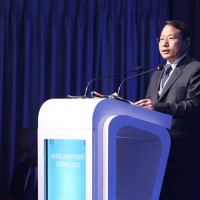- Sunday, 28 April 2024
Addressing Healthcare Inefficiency In Nepal
While Nepal has made significant strides in improving health indicators in recent decades, numerous inefficiencies continue to hinder optimal healthcare delivery. The government is under tremendous pressure to use its scarce resources wisely and sensibly. Every year, there are more demands to increase the budget in healthcare by the three tiers of government—federal, provincial, and local. In this context, ensuring efficient and effective healthcare delivery is a top priority for politicians, policymakers, and healthcare managers. The uneven distribution of medical personnel, with a concentration in urban areas, widens the gap in access to specialised care for rural populations. Additionally, inadequate training opportunities and limited career progression options lead to brain drain, further strain the healthcare system, and create pressure for more investment.
Inefficiencies in healthcare refer to situations where resources are not used effectively to deliver the best possible care to service users. This can manifest in several ways, leading to negative consequences for both patients and the healthcare system as a whole. Inefficiencies in healthcare can have a direct impact on health service users, which may impact their health negatively and hinder their experience with medical institutions and systems. Inefficiencies within the healthcare system can lead to suboptimal resource allocation for health services. It also reduces economic productivity, as a population burdened by ill health cannot contribute optimally to the nation's economic growth and development. The financial burden of healthcare is a significant barrier for many citizens. Out-of-pocket expenses for treatment and medication can be crippling, leading to delays in seeking care and worsening health outcomes. Limited public health insurance coverage and a fragmented health financing system further restrict access to quality care.
Resource mismanagement
A higher cost of health delivery does not mean better services for health service users. Medical institutions face steadily increasing pressure to take costs out of the system or reduce surpluses while maintaining or increasing the quality of care. Insufficient funding allocated to the health sector constrains the government's ability to address the problems faced by the healthcare system. Weak governance, bureaucratic red tape, and corruption further impede the efficient allocation and utilisation of resources. Many factors contribute to inadequacies in the healthcare sector. Finding out the root cause of this inability and its impact on healthcare is important to propose potential solutions to pave the way for a more robust system.
The healthcare budget consumes a major chunk of Nepal’s resources and has been increasing year over year. According to the latest figures, Nepal spends almost 4 per cent of its GDP on healthcare. According to the Health Financing Policy 2080–2090 (published by the Ministry of Health and Population), the government aims to spend at least 10 per cent of the budget on health by federal, provincial, and local governments. This expectation or aim has become just a fantasy. According to a research paper titled ‘Impact of Federalization for Health Financing and Workforce in Nepal’, the federal government spent 2.4 per cent of its GDP on health services in 2020–21. One of the problems of Nepal’s health care system is inadequacies. These inadequacies can manifest in various forms and affect different aspects of healthcare delivery.
Inefficiencies can be observed in many public healthcare organisations across the country. One of the most common problems in the form of inefficiency in Nepal is corruption. As a result, a huge sum of monetary resources is misused and wasted. It can happen during the procurement of equipment, consumables, supplies, or services. Paying excess costs for healthcare products, consumables, and services is an example of inefficiencies in healthcare. Similarly, purchasing low-quality products can be seen in many instances for public medical institutions. We also often hear that public healthcare organisations stock out-of-date products, medications, and consumables. Inefficient or delayed delivery of products or services can also be observed in Nepal. These are some examples of corrupt practices.
Healthcare challenges
The healthcare system might waste resources by assigning highly skilled (and expensive) healthcare professionals to deliver healthcare that could be efficiently performed by less specialised personnel. Waste in the healthcare system includes unnecessary diagnostic tests, brand-name drugs over generics, and extended hospital stays beyond medical necessity due to poor medical practices. Errors in prescribing, dispensing, or administering medications can occur due to factors such as illegible handwriting, miscommunication, or a lack of medication reconciliation. These medication errors can lead to adverse drug reactions, treatment delays, hospital readmissions, and increased healthcare expenditures, highlighting inefficiencies in medication management processes. These inefficiencies cripple both payers, who waste money, and health service users, who receive substandard care or are denied proper treatment due to resource limitations. The government spends a significant sum of money every year on the development of health infrastructure. It is the belief amongst the public that no infrastructure is built in Nepal without bribery, fraud, or corruption.
These examples underscore the diverse nature of inefficiencies in healthcare, which emphasises the importance of identifying and addressing systemic challenges to enhance the quality, accessibility, and affordability of treatment access. By addressing inefficiencies proactively and implementing strategies to optimise resource utilisation, the system can strive to deliver more efficient, effective, and patient-centred care.
Innovative solutions
Technology offers tremendous potential to reduce waste and improve healthcare delivery. Telemedicine consultations can connect patients in remote areas with specialists; electronic medical records can streamline care coordination; and mobile health platforms can offer access to health information and resources. Now is the time to invest in smart and innovative health technologies for better health outcomes in a cost-effective way. Reducing avoidable, ineffective, and duplicate use of health services are other ways of reducing the cost burden and removing inefficiencies in healthcare.
Investing in health education campaigns to raise awareness about preventive healthcare practices, tackle misinformation, and promote cultural sensitivity among healthcare professionals is vital to delivering efficient and effective treatment services.
By introducing and applying cost measurement, cost analysis (such as activity-based costing), cost containment, avoidance, and reduction measures, healthcare institutions in Nepal can deliver cost-efficient services. Healthcare organisations should also focus on making healthcare processes more efficient so that lean healthcare can be delivered, and process or cost efficiency can be achieved. Healthcare institutions and government authorities should make every effort to ensure the appropriate costing of goods and services, the use of appropriate healthcare professionals or a specialty mix and reduce administrative costs.
Way forward
Nepal’s journey towards an efficient healthcare system is both challenging and promising. By addressing inefficiencies, the country can pave the way for better health outcomes for its citizens. Addressing inefficiencies requires a comprehensive approach that tackles poor governance and corruption issues, costing of services, infrastructure challenges, human resource shortages, financial constraints, and inefficient processes. By investing in the right healthcare infrastructure, strengthening the skill mix and human resource capacity, improving financial management, implementing good healthcare governance, and engaging communities, Nepal can make significant strides towards achieving universal health coverage and improving health outcomes for its population. Collaborative efforts involving government agencies, healthcare professionals, civil society organisations, and international partners are essential to overcome the complex challenges and build a more resilient and equitable healthcare system for all.
(Dr. Kaini is a senior lecturer of Healthcare Management and Leadership at Anglia Ruskin University, Faculty of Health, Medicine, and Social Care, UK.)

















